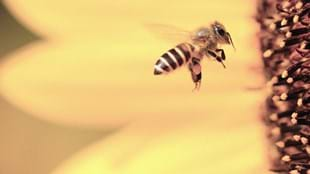About ten years ago beekeepers in the United States realized something was going wrong with their bees, that thousands of hives were empty. This raised a global concern about what was called Colony Collapse Disorder which, as it became apparent, was affecting bees in other parts of the world as well as wild bees.
We need the bees, not for honey to put on our toast, but to pollinate the plants that produce many of the crops upon which we depend. The value of bees is hard to quantify, although a 2009 study which measured the contribution of insect pollination to the economic value of the world’s agricultural output calculated the service of bees to be worth US$168 billion per year.
Colony Collapse Disorder is now recognized as a complex problem with myriad causes. It could be partly attributed to the parasites and diseases that have, as a result of international commerce, been moved around the world to places were the local bees don’t have much resistance; diseases such as American foulbrood and chalkbrood; or to parasites such as the varroa mite, acarina mites and the African hive beetle.
It could be due to loss of habitat and access to natural food sources, as well as the agricultural practice of planting only one crop in entire regions (monoculture). A planted crop might flower and provide a source of food for bees, but a single plant cannot meet all their nutrient needs.
Some researchers have found that air pollution from automobiles and power plants could be inhibiting the ability of bees and butterflies to detect and locate the fragrances of flowers. The Intergovernmental Panel on Climate Change (IPCC) has reported that bees and butterflies and other pollinators face the risk of extinction because of alterations in the seasonal behavior of species, with bees emerging at different times in the year when flowering plants aren’t around.
Pesticides have also been blamed, particularly neonicotinoid insecticides. They’ve been in the news again since two studies published in Science in June this year indicated (or, depending on who you read, “confirmed”) they were having a negative effect on the health of bees. Many environmentalists say we need to ban them immediately. But do we? We asked Phil Lester, Professor of Ecology and Entomology at Victoria University in New Zealand.
What exactly are neonicotinoids?
They’re one of the most widely used pesticides around the world, a neurotoxin, that interferes with the nervous system and brain function, and which are quite specific to insects. Depending on the dose, they can have lethal effects on insects by stopping the nervous system, but they can also have sublethal effects at smaller doses – bees, for instance, might find it difficult to find their way home to the hive, affecting their ability to forage. Neonicotinoids are chemically similar to nicotine, and I don’t know what it feels like to be an insect, but I wonder if in smaller doses it might feel a bit like having a smoke behind the bike shed as a kid, and you got a bit dizzy.
Why are neonicotinoids so popular?
The big benefit is that they are typically coated onto seeds before planting and the plant will express them throughout the plant. That means you don’t have to spray large areas with broad-spectrum pesticides that are going to kill off all sorts of things that don’t feed on the plant, such as organisms that might be in the soil or insects that are simply passing through. Unfortunately, neonicotinoids are expressed in the pollen and the nectar, so pollen-feeding insects are going to be exposed to them, which is where the problem is.
“Ecologists like me would like no insecticides to be used whatsoever, because you’re always going to have at least some non-target effects if you use them. But at this stage, we need them.”
- Phil Lester
That is a problem for bees...
We know that large amounts of neonicotinoids can be fatal to honey bee workers and queens, and at smaller doses, their foraging becomes less efficient, their immune system seems to be impaired, and it also has a negative effect on their tolerance of other stressors like exposure to fungicides. The Canadian study published in Science is consistent with these findings and a considerable body of previous research.
The European study published in Science was massive, a fantastic large-scale study. The researchers looked at the effects of neonicotinoids on honey bees in large experiments replicated in three different countries. But what came out of it was that there was no real consistent effect across all of those countries.
Can you elaborate?
The researchers looked at a wide array of honey bee life history traits, but let’s look at two statistically significant effects – the number of honey bee egg cells produced, and the number of bumblebee drones produced. These variables showed major changes but differed between countries. In Hungary, there were some really negative effects, in Germany, the study showed quite positive effects, and in England, it didn’t seem to have much effect. The authors, and the media around this, have claimed that the study showed that neonicotinoids are bad, but the data doesn’t show that they are uniformly bad everywhere. In fact, for countries like Germany, neonicotinoids seemed to be beneficial for bees. The results make drawing an overall conclusion on neonicotinoid effects difficult, if not impossible.
Why are the results of different countries so different – is it about the crops being grown, the methods of application, what other plants are being grown?
It’s not clear, but from what I’ve read or heard of these study sites, Germany has a much higher diversity of pollen sources than Hungary does – so there are a range of different crops and flowers that bees could forage on in Germany. That floral diversity in Germany might “dilute” or even eliminate any effects of the pesticides. That logic makes sense to me – if the bees are reliant on one pollen source and that pollen source has neonicotinoids in them, then the bees are going to be much more exposed. So in Hungary, it would seem logical to not use neonicotinoids, but if I was a German grower, I’d be upset to be deprived of this pesticide as a production tool; the study showed no statistically significant negative effects there, and some statistically significant positive effects.
But do we really need insecticides?
Unfortunately, we are in a situation where we are reliant on them to feed the world. It would be nice to imagine we wouldn’t be, and I’m sure that growers and farmers would be very pleased if they didn’t have to spend money on pesticides. There are currently some crops that can be grown utilizing organic methods, but we are a long way off not having to use insecticides for a lot of staple crops. Many of them would be eaten to bits.
Ecologists like me would like no insecticides to be used whatsoever because you’re always going to have at least some non-target effects if you use them. But at this stage, we need them, and the question is which ones are going to have the least non-target effects? I suspect that at the moment, neonicotinoids are one of the better candidates, as the lack of a need to spray makes them much more targeted.
We need pesticides that have the least impact on our biodiversity, that are specific to killing off pests and nothing else … We’d all like to see a move away from all pesticides, but right now they’re essential, and we shouldn’t get rid of any one particular chemical until we have the data to support the argument that we should. If growers have to replace one pesticide with another, it’s quite possible that the other might well be worse.

Phil Lester is a Professor of Ecology and Entomology at Victoria University in New Zealand. His work studies the dynamics of invasive species and the potential role of pathogens and the insect immune system in the population collapses. He is also examining interactions between bacteria and viruses in honey bees as a method of mitigating the effects of parasitic mites.
Follow the freshest thinking @fitplanetmag.







